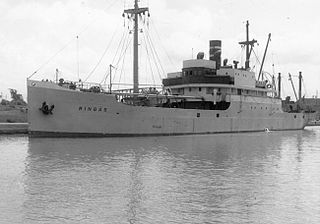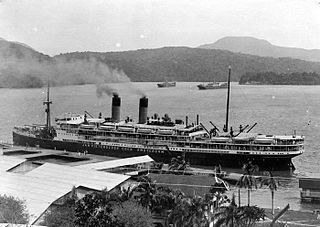
USS Alameda, was a United States Navy tanker in commission from 1919 to 1922. She was built as the civilian tanker SS Alameda, but transferred to the U.S. Navy after completion in 1919. She was sold for commercial service and operated under the names SS Olean and SS Sweep before she was transferred to the Navy again in World War II as USS Silver Cloud (IX-143).

The Greek Ship is the nickname of a cargo steamship, Khoula F, that has been beached on the southwest coast of Kish Island, Iran, since 1966. She was built in 1943 by the British shipyard of William Hamilton and Company in Port Glasgow, Scotland, under the name Empire Trumpet. From 1946 to 1966, she passed through a series of British and Iranian owners and various changes of name. Her final owners were Greek.

SS Potsdam was a steam ocean liner that was launched in Germany in 1899 for Holland America Line. In 1915 Swedish American Line acquired her and renamed her Stockholm.

SS Empire Simba was a British steam-powered cargo ship. She was originally an American ship, launched in 1918 as SS West Cohas. During a stint in the United States Navy from 1918 to 1919, she was called USS West Cohas (ID-3253).

SS Polar Chief was a merchant steamship that was built in England in 1897 and scrapped in Scotland in 1952. In her 55-year career she had previously been called Montcalm, RFA Crenella, Crenella, Rey Alfonso, Anglo-Norse and Empire Chief. Early in the First World War she spent eight months pretending to be the battleship HMS Audacious.
Clan Matheson was a 5,614 GRT cargo ship that William Hamilton & Co Ltd of Port Glasgow built in 1919 as Clan Morgan for Clan Line Steamers Ltd. She was sold in 1948 and renamed Harmodius. In 1951 she was sold again and renamed Claire T. In 1955 she was bought by the Ministry of Transport (MoT) which renamed her Empire Claire. She was scuttled on 27 July 1955 with a cargo of obsolete chemical materiel.

Francisco Morazan was a 1,442 GRT cargo ship that was built in 1922 as Arcadia by Deutsche Werft, Hamburg, for German owners. She was sold in 1934 and renamed Elbing. She was seized by the Allies in the River Elbe, Germany in May 1945, passed to the United Kingdom's Ministry of War Transport and renamed Empire Congress. In 1946, she was allocated to the Norwegian Government and renamed Brunes.
SS Lulworth Hill was a British cargo ship completed by William Hamilton & Co in Port Glasgow on the Firth of Clyde in 1940. Lulworth Hill had a single 520 NHP triple-expansion steam engine driving a single screw. She had eight corrugated furnaces heating two 225 lbf/in2 single-ended boilers with a combined heating surface of 7,643 square feet (710 m2), plus one auxiliary boiler.
SS Marietta E was a British cargo ship completed by William Hamilton & Co in Port Glasgow on the Firth of Clyde in June 1940. She had a single 520 NHP triple-expansion steam engine built by David Rowan and Company of Glasgow, that drove a single screw. She had eight corrugated furnaces heating two 225 lbf/in2 single-ended boilers with a combined heating surface of 7,643 square feet (710 m2), plus one auxiliary boiler.
SS Canadian Constructor was a 7,178 GRT refrigerated ship built in 1922 by Halifax Shipyards Ltd in Nova Scotia.
Counties Ship Management Co. Ltd. (CSM) was an ocean-going merchant shipping company based in the United Kingdom. During the Second World War CSM merchant ships made a substantial contribution to supplying the British war effort, at a cost of 13 ships lost and 163 officers and men killed.

Western Maid was a 5,760 GRT cargo ship that was built in 1918 by the Northwest Steel Company, Portland, Oregon, USA. She was built for the United States Shipping Board (USSB), but was commissioned into the United States Navy on completion as USS Western Maid, with the pennant number ID-3703. In 1919 she was decommissioned and returned to the USSB. In 1937 she was passed to the United States Maritime Commission. In 1940 she was transferred to the British Ministry of Shipping and renamed Empire Cormorant, passing to the Ministry of War Transport (MoWT) in 1941. In 1945 she was scuttled in the North Atlantic with a cargo of obsolete war matériel.
SS Glentworth was a shelter deck cargo steamship built in 1920 by Hawthorn Leslie & Co. in Newcastle-upon-Tyne, England for R.S. Dalgliesh and Dalgliesh Steam Shipping Co. Ltd., also of Newcastle-upon-Tyne. After the Great Depression affected UK merchant shipping in the first years of the 1930s, Dalgliesh sold Glentworth to a company controlled by Counties Ship Management who renamed her SS Box Hill.
SS Empire Tower was a British 4,378 GRT cargo ship built in 1935 and sunk by enemy action in 1943.

SS Wairuna, originally called D/S Schneefels, then SS Gibraltar and SS Polescar, was a cargo steamship that was launched in Germany in 1913. She had a varied career spanning three decades under successive German, British and New Zealand owners before being scuttled in the North Atlantic in 1945.
SS Almeda Star, originally SS Almeda, was a British turbine steamer of the Blue Star Line. She was both an ocean liner and a refrigerated cargo ship, providing a passenger service between London and South America and carrying refrigerated beef from South America to London. She was built in 1926, significantly enlarged in 1935 and sunk by enemy action in 1941.
SS Darien was a refrigerated cargo ship of the United Fruit Company. Cammell Laird of Birkenhead, England built her as MV La Marea, completing her in 1924. She had been renamed Darien by 1930 and had been re-engined from diesel to steam by 1931.

SS Jan Pieterszoon Coen was a Dutch passenger steamship that was launched in 1914. She was named after a former Governor-General of the Dutch East Indies. During the German invasion of the Netherlands in May 1940 she was scuttled as a blockship in the port of IJmuiden, North Holland to prevent the Kriegsmarine from using the port.
SS Verdala was a cargo and passenger steamship that was built in Scotland in 1913. Several times she changed owners and was renamed: as Mongolian Prince in 1917, Istok in 1928 and finally Maycrest in 1940.

SS Aquileia was a Dutch-built steamship that was launched in 1913 as the ocean liner and mail ship Prins der Nederlanden for Netherland Line. She ran scheduled services between Amsterdam and the Dutch East Indies until 1930, when she was laid up.










